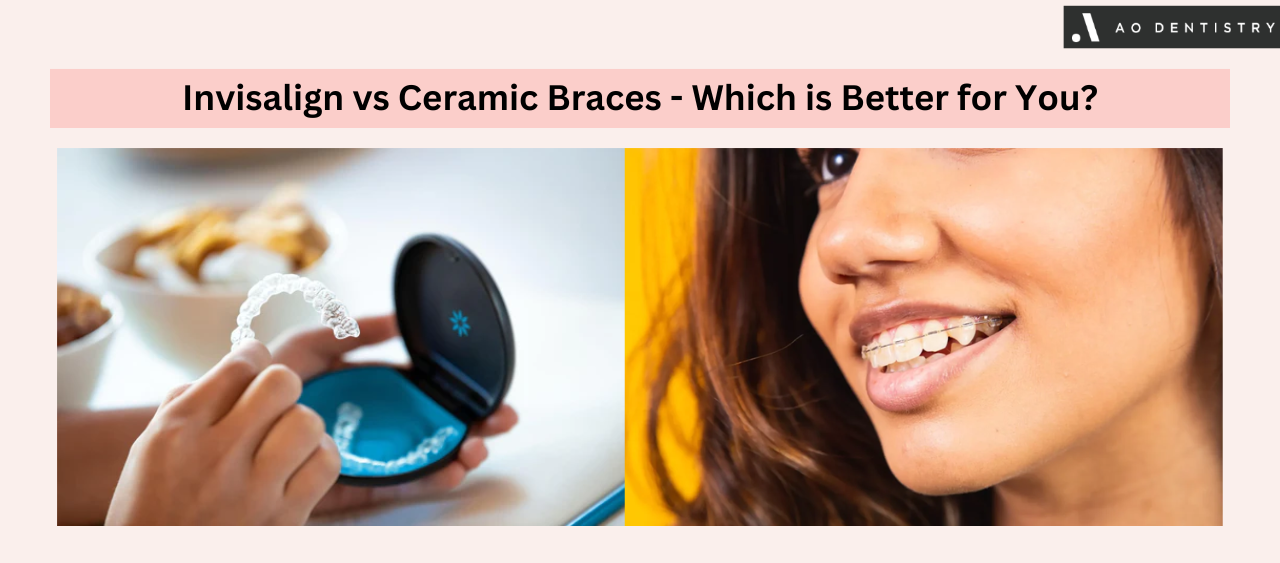When it comes to orthodontic treatments, two popular options often emerge: Invisalign and ceramic braces. Both serve the same purpose—aligning your teeth and enhancing your smile—but they cater to different needs and preferences. In this blog, we’ll explore the key differences, benefits, and considerations to help you decide between Invisalign and ceramic braces.
What is Invisalign or Clear Aligners?
Invisalign is a modern orthodontic solution that uses clear, removable aligners to straighten teeth. The aligners are custom-made to fit your teeth and apply gentle pressure to shift them into the desired position over time. Invisalign has gained popularity for its discreet appearance and convenience, making it an appealing choice for adults and teenagers.
You also know more about Clear Aligners in Pune here.
Advantages of Invisalign:
- Discreet Appearance: The clear aligners are virtually invisible, allowing you to straighten your teeth without the noticeable look of braces.
- Removability: Unlike traditional braces, Invisalign aligners can be removed while eating or brushing, ensuring better oral hygiene.
- Comfort: The smooth plastic material minimizes irritation to your gums and cheeks.
- Fewer Appointments: With Invisalign, you typically visit the dentist less frequently as aligners are pre-made for each stage of the treatment.
You can also know more about Benefits of Dental Implants here.
Disadvantages of Invisalign:
- Cost: Invisalign aligners is often more expensive than ceramic braces.
- Discipline Required: Since the aligners are removable, they require commitment to wear them for 20-22 hours daily for effective results.
- Not Ideal for Complex Cases: Invisalign may not be suitable for severe dental misalignments or bite issues.
What are Ceramic Braces?
Ceramic braces are similar to traditional metal braces but use tooth-colored or clear brackets, making them less noticeable. These braces are fixed and work effectively for various orthodontic cases, including complex ones.
Advantages of Ceramic Braces:
- Aesthetic Appeal: The brackets blend with the teeth, making them less conspicuous than metal braces.
- Effective for Complex Cases: Ceramic braces can treat a broader range of dental misalignments compared to Invisalign.
- Durability: While less visible, ceramic braces are still robust and effective for long-term treatments.
You can also read about Home remedies for swollen gums here.
Disadvantages of Ceramic Braces:
- Staining Potential: The clear or tooth-colored brackets may stain if not maintained properly.
- Fixed Nature: Unlike Invisalign, ceramic braces cannot be removed, which may restrict food choices and make oral hygiene more challenging.
- Cost: Ceramic braces are typically more expensive than traditional metal braces but cheaper than Invisalign.
You can also read more about Dental Implants parts.
Invisalign vs Ceramic Braces: Key Differences
When comparing Invisalign vs ceramic braces, the primary differences lie in appearance, treatment process, and suitability. Here’s a breakdown:
| Feature | Invisalign | Ceramic Braces |
|---|---|---|
| Appearance | Virtually invisible | Tooth-colored or clear brackets |
| Comfort | Smooth plastic aligners | Brackets and wires may cause irritation |
| Removability | Yes | No |
| Maintenance | Easy to clean and removable | Requires careful cleaning to prevent staining |
| Treatment Time | 12-24 months (varies) | 12-24 months (varies) |
| Cost | Higher than ceramic braces | Cheaper than Invisalign |
| Suitability | Mild to moderate cases | Mild to complex cases |
You can also read more about Invisible aligners here
Which is Right for You? Invisalign vs Ceramic Braces
The choice between Invisalign or ceramic braces ultimately depends on your needs, lifestyle, and budget. If you value discretion and convenience, Invisalign might be the ideal option. However, if your case is more complex or you prefer a fixed solution, ceramic braces could be the better fit.
Factors to Consider Before Choosing Invisalign or Ceramic Braces:
- Complexity of Your Case: Consult with your orthodontist to determine the best treatment for your specific dental issues.
- Budget: Invisalign is generally more expensive than ceramic braces, so consider your financial plan.
- Lifestyle: If you lead a busy lifestyle and can’t commit to wearing aligners consistently, ceramic braces may be more practical.
- Aesthetic Preference: Both options are discreet, but Invisalign offers a higher level of invisibility.
Wanna know about Cosmetic Dentistry? Have look at our Cosmtic Dentistry in Pune page.
Invisalign vs Ceramic Braces: Final Thoughts
Invisalign and ceramic braces are excellent choices for achieving a straighter smile. By understanding their unique features and differences, you can make an informed decision that aligns with your preferences and dental requirements. Whether you choose Invisalign or ceramic braces, consulting an experienced orthodontist is essential to ensure the best results.
If you’re still unsure, schedule a consultation with a professional to explore your options further. Your journey to a confident smile begins with the right choice of orthodontic treatment.
FAQ’s
Q1. Which is better Invisalign or ceramic braces?
Ans. It depends on your needs. Invisalign is discreet and removable, ideal for mild to moderate cases. Ceramic braces are better for complex cases but are fixed and more visible.
Q2. Which is faster clear braces or Invisalign?
Ans. Treatment time is similar (12-24 months), but ceramic braces might be faster for complex cases since they exert continuous pressure.
Q3. What is the disadvantage of ceramic brackets?
Ans. Ceramic brackets can stain over time, are more fragile than metal braces, and require careful cleaning to maintain appearance.
Q4. Is it better to get braces or Invisalign?
Ans. Braces are better for complex issues; Invisalign suits those seeking a removable and less noticeable option. Consult your orthodontist for personalized advice.
Q5. Are ceramic braces more expensive than Invisalign?
Ans. No, ceramic braces are generally less expensive than Invisalign, though the cost varies based on the treatment plan and location.
Q6. Do Invisalign aligners hurt less than ceramic braces?
Ans. Yes, Invisalign aligners are usually more comfortable as they lack wires and brackets that can irritate the mouth.
Q7.How often do ceramic braces need adjustments?
Ans. Ceramic braces typically need adjustments every 4-6 weeks during orthodontic appointments.
Q8. Are Invisalign aligners difficult to clean?
Ans. No, Invisalign aligners are easy to clean. Rinse them with lukewarm water and brush gently with a soft toothbrush daily.










